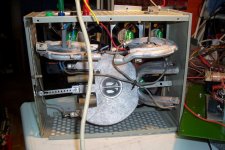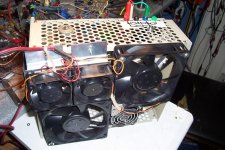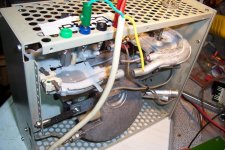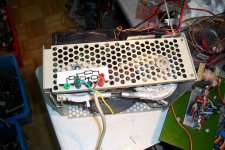Hi there,
For the final development of my E-variac, I needed a high-power, configurable load that could operate for extended periods of time.
This is what I improvised, using heating elements cannibalized from old coffee machines.
I had two left in the attic, and found two more at my in-laws.
These elements are quite suitable: they are compact, of a consistent and reasonable power (~750W), and unlike incandescent lamps, they are linear.
Of course, they cannot operate without cooling, except at low power, or for very short durations.
I crammed them into an old chassis, together with a number fans.
I can configure the load for 450W, 500W, 750W, 1150W, 1900W, 2250W, and with 45W of cooling power, it can easily operate continuously.
Ugly but effective!
For the final development of my E-variac, I needed a high-power, configurable load that could operate for extended periods of time.
This is what I improvised, using heating elements cannibalized from old coffee machines.
I had two left in the attic, and found two more at my in-laws.
These elements are quite suitable: they are compact, of a consistent and reasonable power (~750W), and unlike incandescent lamps, they are linear.
Of course, they cannot operate without cooling, except at low power, or for very short durations.
I crammed them into an old chassis, together with a number fans.
I can configure the load for 450W, 500W, 750W, 1150W, 1900W, 2250W, and with 45W of cooling power, it can easily operate continuously.
Ugly but effective!
Attachments
Cool (or rather: hot!); what resistor values do these heaters have? Water cooling seems an obvious option...
Samuel
Samuel
Around 65ΩCool (or rather: hot!); what resistor values do these heaters have?
Probably too obvious.Water cooling seems an obvious option...
It would require plumbing, pumping and some form of radiator because water alone doesn't cool by itself: it first accumulates some heat, and then begins to boil
Agreed, but water in means tap supply or tank, water out = drain or another tank, flow control, leak-proof plumbing, etc.Or just let it flow,let it flow... Down the drain.
1 l/min, +30C centigrade = 2100 W cooling.
Not very appealing for something that is going to be operated at a few hundreds of volts.
I prefer to keep everything dry, and at a 2~3kW power level, it is perfectly possible
.. heating elements cannibalized from old coffee machines.
Nice. It was once common to see broadcast transmitter dummy loads capable of dissipating tens of kilowatts cobbled together from electric oven elements.
Cool (or rather: hot!); what resistor values do these heaters have?
These elements are rated in terms of wattage and operating voltage from which ohms can be calculated by simply applying Ohm's law.
- Status
- Not open for further replies.
- Home
- Design & Build
- Equipment & Tools
- The Franken-Load



